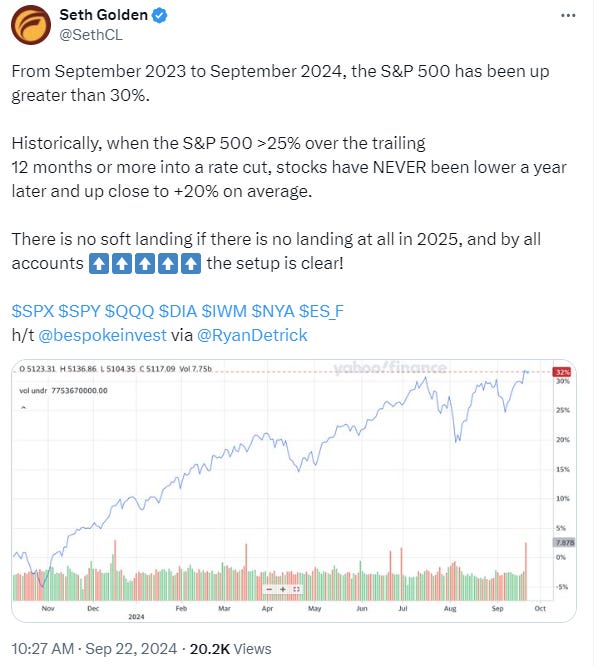Liquidity is alive and well
The FOMC decided to lower the benchmark interest rate, the FFR, by 50 basis points. This was not the rate cut that most economists were anticipating (including me), but looking back, the Fed should have probably cut by 25 in July. The BLS has not been doing a stellar job on accurately reporting labor statistics and have needed to do many revisions lower to their numbers. I think this worried the Fed decision makers as unemployment is half the mandate.
You can see the whole press conference here, transcript here. I thought the press did a fair job questioning Fed Chairman Powell on how this decision was made, the data that the Fed took into consideration (hello Beige Book) and how the Fed’s SEP (Summary of Economic Projections) would be a roadmap to year-end.
I found the most interesting question to be the balance sheet run-off exchange between WSJ’s Nick Timiraos.
NICK TIMIRAOS. And if I could follow-up on the balance sheet, in 2019 when you did the mid-cycle adjustment, you ceased the balance sheet runoff. With a larger cut today, is there any, should there be any signal inferred about how the Committee would approach and state on the balance sheet policy?
CHAIR POWELL. So, in the current situation, reserves have really been stable, they haven't come down. So reserves are still abundant and expected to remain so for some time. As you know, the shrinkage in our balance sheet has really come out of the overnight RRP. So, I think what that tells you is we're not thinking about stopping runoff because of this at all. We know that these two things can happen side by side, in a sense they're both a form of normalization and so for a time you can have the balance sheet shrinking but also be cutting rates.
As John Williams said so long ago, the RRP facility is “working as planned”. By continuing the balance sheet runoff, the Fed is running a reverse QE (called QT or quantitative tightening). One of the best minds regarding Quantitative Easing is Dr Richard Werner, who wrote an incredible article about fiscal debt, QE, and central banking on Monday.
The idea behind QE is to have the central bank purchase non-performing assets from banks at face value. This allows banks to remove toxic assets from their balance sheet and re-orient their capital giving them the ability to lend more dollars into existence, increase the money supply, and juice the economy.
Shortly after the Fed’s decision, the People’s Bank of China (PBOC) introduced easing measures such as lowering reserve requirements, cutting interest rates, and providing leverage to brokers. This reads like desperation to me. China’s economy will get a shot in the arm from this liquidity but if the past is prologue, it will not last and will most likely turn into disaster.
But before investors start celebrating, it's helpful to know that China’s track record with these big stimulus pushes has been mixed to poor.
In 2008, the country's massive infrastructure spending led to unsustainable debt. Fast-forward to 2015, and a stock market crash wiped out gains despite similar interventions. And during the pandemic, the Chinese property sector collapsed after another stimulus effort fueled a bubble.
The question on everyone’s mind: Will China add fiscal stimulus to that record?
Yes. So where will the money go?







